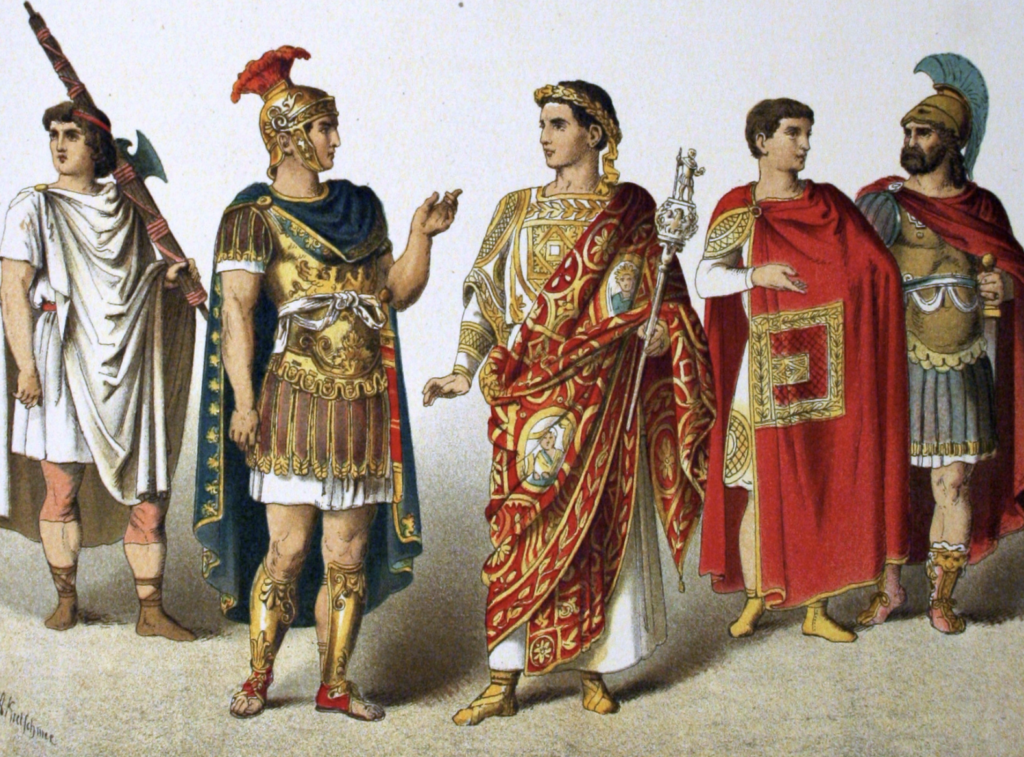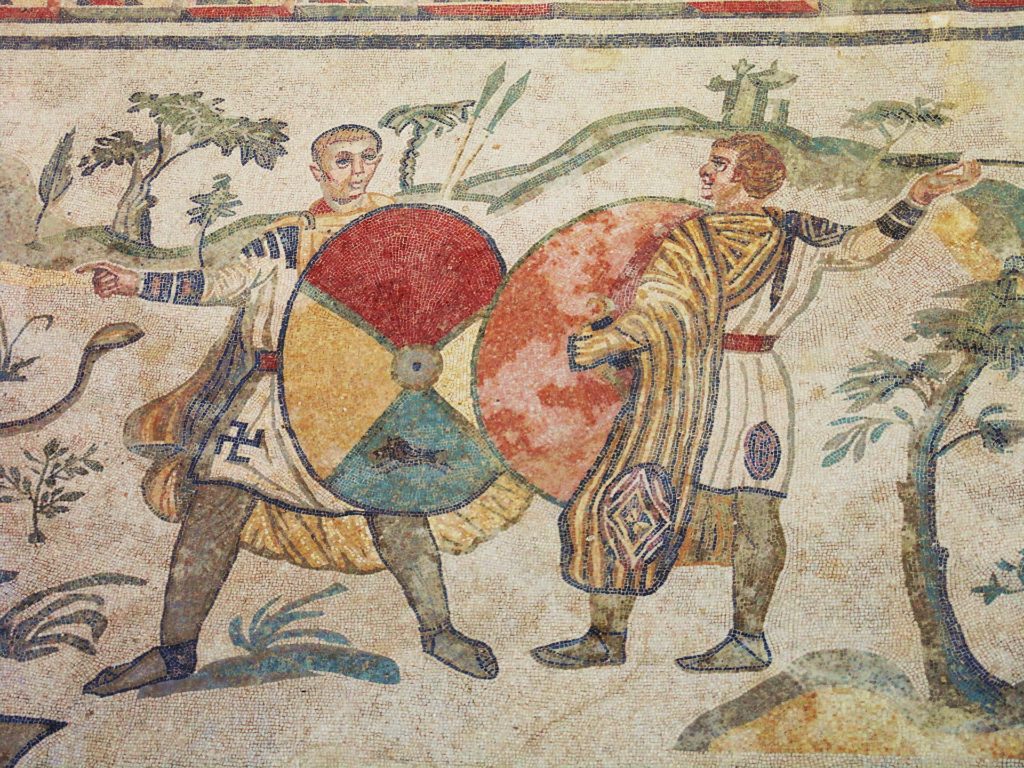Last updated on July 22nd, 2022 at 09:49 pm
The visitor to the Louvre Museum in Paris regularly passes statues from the ancient world when the Romans dominated the Mediterranean and much of Europe. Generally speaking, these statues have a uniform look to them, as do the figures depicted on Roman mosaics, like those found in the ruins of Pompeii today.
Generally speaking, all of these figures are wearing togas or the female equivalent called the stola. These long robes of heavily folded cloth, secured over one shoulder, or often two in the case of the stola, are the quintessential Roman attire.
But one often wonders when looking at this impractical clothing, how on earth did these people manage to go about their daily work, let alone conquer most of the known world, dressed like this?

Romans Didn’t Always Wear Togas
The answer, in short, to this question is that the Romans did not generally wear togas or stolas, despite their ubiquity in decorative mosaics and sculptures of the time. Instead, togas and stolas were the formal dress of the upper class, a small minority within Roman society who did not carry out any physical work to speak of and could wear impractical robes a large proportion of the time.
Thus, togas and stolas would have been the standard dress at a Roman banquet or attending the Senate or the courts and temples.
And because the Romans were a severely hierarchical and elitist society, this form of dress of the upper class and ruling patricians tended to be depicted on mosaics and in statues. Consequently, our view of Roman clothing is highly skewed to over-represent the toga and stola.
If not Togas, then what did Romans Wear?
If most Romans did not wear togas or stolas daily, what did they wear? The reality was much more practical. Most people wore long sleeveless tunics over some undergarments, unlike wearing a pair of shorts and a t-shirt.
It certainly allowed for the same level of maneuverability and kept the wearer calm in a world where most of the empire’s cities were located along the warm Mediterranean coastline. This would have been somewhat different in Roman Britain and the Low Countries, where the climate was cooler, and they would wear a mantle of some heavier material over the tunic.

Footwear was mixed and, much like in the modern world, varied according to the climate of a given country and the social occasion involved.
The most common type of shoe was a one-piece called a carbatina, which often was hobnailed to provide extra grip. A thin-soled sandal called the solea was also popular, particularly in the Mediterranean. These were secured with thongs rather than a clasp. Soldiers and other laborers generally wore a heavy-duty boot called caliga.
High heels were not a feature of Roman dress, though platforms made from cork wood were attached to the bottom of sandals, and they wore these both in theatrical performances at amphitheaters and by prostitutes.
What did Roman Slaves Wear?
Slaves, as with most other things in Roman society, generally had a basic standard of apparel. Tunics would consist of cheap wool or cloth in the most basic colors.
As they were often engaged in heavy labor on farms or building sites, slaves generally wore heavy-duty shoes or boots and clothing appropriate for this kind of work.
However, others would have been better attired. Many patricians and magistrates across the empire believed the appearance of their slaves was a reflection of their social status. So some slaves were well dressed, with their clothing often bearing the insignia or livery of their owner’s clan or their rank.
What Material Were They Made From?
Clothing for all social classes was available in many different fabrics and colors. Silk was the most prized material which clothes were produced from. This was obtained through trade with the Far East, which was more extensive than previously appreciated.
The Romans even established trading stations in Central Asia in regions that they did not control to facilitate this. Indeed so significant was the trade with China to obtain the fabric that the Romans called the region ‘Serica’, a name which effectively means something equivalent to ‘The Land of Silk’.
Damask and linen made from flax and hemp were also valued, and they extensively used the cloth. Vivid dyes were available. For instance, the bright red color, which is so synonymous with the uniforms of the Roman legionaries, was obtained from rose madder. They could get Blue from indigo and other blue pigments traded extensively through Egypt and Arabia.
However, the most prized color was Tyrian Purple, a color that they could only obtain through the 6,6’-dibromoindigo chemical collected from sea snails.
Unfortunately, they needed thousands of snails to obtain quantities sufficient to dye whole robes. So Tyrian Purple, named after the Phoenician city of Tyre in the Levant, where people first discovered it, became extremely expensive.
So prized was it that during the imperial period, Rome implemented laws whereby the color could only be used on clothes worn by the emperor, the imperial family, and select individuals given the privilege of wearing ‘the imperial purple’.
Clothing in the Late Roman Empire
Inevitably, clothing fashion changed over time in an empire that lasted nearly a millennium between the Republican and Imperial periods. By the third century AD, the toga and other types of traditional dress were increasingly out of fashion.
In large part, this was owing to provincial Romans gradually adopting the regional dress sense of the subject people of the empire over time.
Thus, Greek fashions became more popular in the Eastern Mediterranean, as did some Egyptian fashions in Alexandria, the second-largest city of the empire located in the Nile Delta. Similarly, they incorporated the more practical apparel worn by the Britons and Celts of Northern Europe into Roman dress in those regions.
Thus, while the toga and the stola predominate in the hallways of the Louvre and the houses at Pompeii today, the reality of Roman dress was often very different.
Sources
Caroline Vout, ‘The Myth of the Toga: Understanding the History of Roman Dress’, in Greece & Rome, Vol. 43, No. 2 (October, 1996), pp. 204–220.
Jerome Carcopino, Daily Life in Ancient Rome: The People and the City at the Height of the Empire (Yale, 2003); Gregory S. Aldrete, Daily Life in the Roman City: Rome, Pompeii and Ostia (London, 2004).
Alexandra Croom, Roman Clothing and Fashion (Stroud, 2010).
C. J. Cooksey, ‘Making Tyrian purple’, in Dyes in History and Archaeology, Vol. 13 (1994), pp. 7–13; J. C. Edmondson and Alison Keith (eds.), Roman Dress and the Fabrics of Roman Culture (Toronto, 2008).

